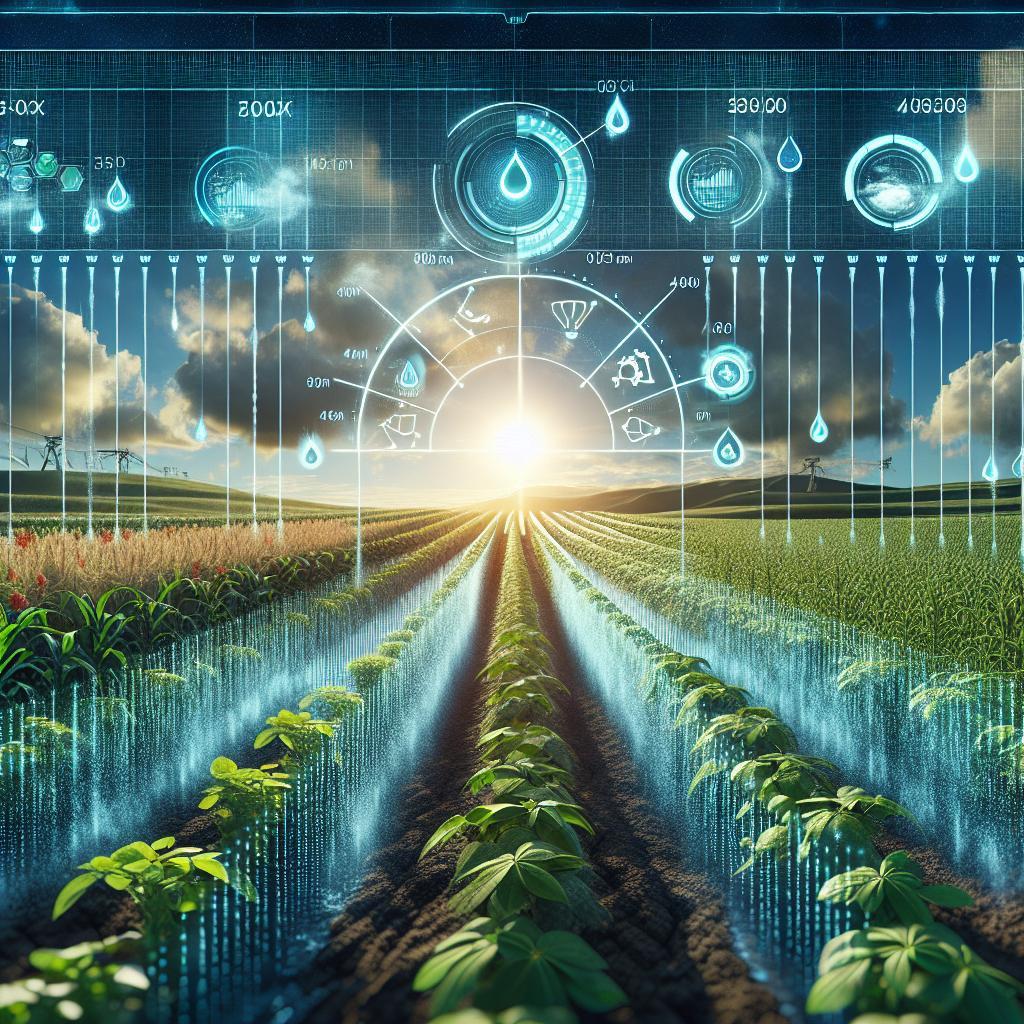This post may contain affiliate links which means I may receive a commission for purchases made through links. Learn more on my Private Policy page.
Introduction:
Imagine stepping into a sun-kissed farm, where rows of vibrant crops sway gently in the breeze, nourished by the perfect touch of water. As any seasoned farmer knows, water is the lifeblood of agriculture, but the key to thriving plants lies not just in abundance but in timing. Are you curious about how to keep your crops happy and healthy without wasting a precious drop? Welcome to the world of efficient watering schedules! In this article, we’ll unveil the secrets to crafting the optimal irrigation routine that not only supports your plants’ growth but also conserves resources for a lasting future. Whether you’re a seasoned pro or just starting your farming journey,get ready to dig into the art and science of watering— because every drop counts!
Understanding Your Crop’s Water Needs
When it comes to keeping your crops healthy, understanding water needs is essential. Each plant type requires a specific amount of water to thrive,which can vary based on several factors including climate,soil type,and growth stage. Recognizing the signs of water stress, such as wilting or yellowing leaves, is crucial for timely intervention. Here are some tips to assess and meet your crops’ needs:
- Monitor soil moisture regularly through probing or sensor technology.
- Consider crop type: leafy greens may need more frequent watering than root vegetables.
- evaluate environmental conditions, like rainfall and temperature, to adjust watering schedules.
planning your watering schedule involves more than just turning on the tap. It is important to integrate factors like plant growth stages, seasons, and weather forecasts. For exmaple, irrigation needs will spike during flowering and fruiting stages.the following table summarizes the general water requirements for common farm crops:
| Crop | Water Needs (inches/week) | Growth Stage Sensitivity |
|---|---|---|
| Tomatoes | 1.5 – 2 | High during fruiting |
| Corn | 1 – 1.5 | Critical during tasseling |
| Carrots | 1 – 1.5 | Moderate throughout growth |
| Cucumbers | 1.5 – 2 | High during flowering |
Timing is Everything: Crafting the Perfect Watering Schedule
When it comes to maximizing crop yields, understanding the best timing for watering is crucial. The ideal schedule for irrigation not only ensures that crops receive the necessary moisture but also conserves water and reduces overall costs. To create a schedule that works effectively, consider the following factors:
- Crop type: Different crops have varying water needs.Determine the specific requirements for each crop variety on your farm.
- Soil Type: Sandy soils drain quickly while clay retains moisture. Tailor your watering frequency based on soil characteristics.
- Weather Conditions: Monitor local weather patterns. Adjust your schedule according to rain forecasts and temperature fluctuations.
- Plant growth Stage: Young plants typically require more consistent moisture, while mature crops may need less frequent watering.
For an effective watering strategy, consider implementing a rotational system. This system allows you to focus on specific sections of your field without over-saturating any area. You can utilize a simple watering table to keep track of each crop’s needs:
| Crop | water Requirement (L/week) | Ideal Watering Time |
|---|---|---|
| Tomatoes | 40 | Early Morning |
| Carrots | 30 | Late Afternoon |
| Leafy Greens | 25 | Midday |
| Potatoes | 35 | Early Morning |
By following this guideline and adjusting your schedule based on the specific needs of your crops and field conditions, you can optimize your watering regimen for both efficiency and productivity. Happy farming!

Techniques for Maximizing Water Efficiency
To ensure optimal hydration for farm crops while minimizing water waste, incorporating smart irrigation systems is essential. These systems,such as drip irrigation and sprinkler systems,deliver water directly to the root zones,reducing evaporation and runoff. Additionally, employing soil moisture sensors allows farmers to monitor the moisture levels precisely, adjusting watering schedules accordingly. Here are some effective practices to consider:
- Water Early or Late: Timing your watering schedule for early morning or late evening helps to reduce evaporation caused by heat.
- Pare Down Watering: Implementing a schedule based on crop types and local weather can considerably enhance efficiency.
- Mulch Application: Applying organic mulch around plants retains moisture in the soil and minimizes the need for frequent watering.
Consider also adopting rainwater harvesting to supplement irrigation needs. Installing rain barrels or cisterns can capture and store seasonal rainfall for use in drier periods, further enhancing water efficiency. An informative comparison of the water needs of various crops can help in developing a strategic irrigation plan:
| Crop | Water Requirement (inches/week) | Ideal Irrigation method |
|---|---|---|
| Tomatoes | 1-2 | Drip Irrigation |
| Corn | 1.5-3 | Sprinkler System |
| Carrots | 1-1.5 | Drip Irrigation |
Adapting to Change: Responding to Weather and Soil Conditions
As farmers, we must embrace the unpredictability of nature, especially when it comes to weather and soil conditions. Understanding the unique characteristics of your land can make all the difference. A few key factors to consider include:
- Soil Moisture Levels: Regularly check and monitor how much moisture your soil retains.This ensures you avoid over- or under-watering.
- Seasonal Changes: Adapt your watering schedule based on whether it’s an exceptionally dry or wet season. Early spring may not need as much water compared to the hot months of July and August.
- Rain Forecasts: Stay updated with local weather reports. Plan your irrigation system to complement upcoming rainfall, maximizing efficiency and minimizing waste.
Additionally, diversifying your irrigation techniques can cater better to varying conditions. As a notable example, combining traditional methods with modern systems could yield the best results. Consider implementing:
| Irrigation Method | Best For |
|---|---|
| Drip Irrigation | Targeted watering for row crops, minimizing evaporation. |
| Sprinkler Systems | Covering larger areas, good for even moisture distribution. |
| Soaker hoses | Increased soil moisture retention, ideal for gardens. |
By tailoring your approach to the current weather and soil conditions, you can promote healthier crops and use resources more efficiently. The art of farming lies in the dance between nature and our management strategies, making adaptability key to a thriving harvest.
To Conclude
As we wrap up our journey through the ins and outs of the most efficient watering schedule for farm crops, it’s clear that the rhythm of nature sings in harmony with a thoughtful approach to hydration. Just like a skilled conductor leading an orchestra, farmers can refine their techniques to ensure every drop of water is maximized, nurturing the seeds of today into the bountiful harvests of tomorrow.
Remember, it’s not just about keeping your crops alive; it’s about cultivating a thriving ecosystem that supports both your farm and the surroundings. Adopting efficient watering methods means you’re not only conserving an invaluable resource but also enhancing the quality of your produce.
So, grab that trusty watering can—or better yet, get familiar with those sprinklers and drip systems! Keep experimenting, stay attuned to the needs of your plants, and watch as your efforts blossom into fruitful results. With the right schedule in place, you can ensure that every plant is as vibrant and strong as the passion you put into your farming.
Thank you for joining us on this watery adventure. Here’s to healthier crops, happier farmers, and a more sustainable future! Happy farming! 🌱💧
This post may contain affiliate links which means I may receive a commission for purchases made through links. Learn more on my Private Policy page.

